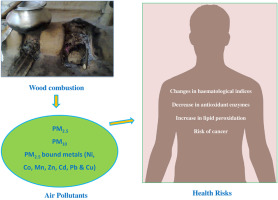Ecotoxicology and Environmental Safety ( IF 6.2 ) Pub Date : 2018-09-12 , DOI: 10.1016/j.ecoenv.2018.09.014 Rumi Rabha , Suraj Ghosh , Pratap Kumar Padhy

|
Chronic smoke exposure, emitted by biomass fuel burning leads to many diseases, which are originated due to oxidative stress. The present study investigated the levels of PM2.5, PM10 and PM2.5 bound trace metals released during cooking with fuelwood and subsequent changes in haematological parameters along with oxidative stress in rural tribal women of northeast India exposed to wood smoke. The levels of PM2.5, PM10 and trace metals associated with PM2.5 (nickel, cobalt, manganese, zinc, cadmium, lead and copper) were measured. In addition, blood samples were analyzed for concentrations of different blood related parameters (haemoglobin, platelet count, red blood cells and white blood cells) and levels of antioxidants (reduced glutathione, superoxide dismutase, and catalase). Plasma malondialdehyde (MDA) was measured as a biomarker of lipid peroxidation. Health risk assessment was done to assess the potential risk posed by inhalation of fine particles emitted from cooking with fuel wood. Levels of both PM2.5 and PM10 were higher in wood users compared to LPG users during cooking period (644.4 ± 368.3 µg/m³ vs 50 ± 23.8 µg/m³; 915 ± 441.3 µg/m³ vs 83.3 ± 33 µg/m³) and it exceeded the permissible limits of WHO. Levels of trace metals during the cooking period in fuel wood users were significantly higher than LPG users (p = 0.01). After controlling possible confounders, both platelet count and white blood cells (WBC) had a significant positive association with PM2.5and PM10. Similarly, haemoglobin had a negative association with both PM2.5 and PM10. Depleted levels of antioxidant enzymes and increase in lipid peroxidation (MDA) suggest a close association with pollutants released from wood smoke, indicating oxidative stress in women who used fuelwood for cooking. The total hazard quotient (HQ) of 0.11 was within the acceptable limit (i.e., 1.0). The total excess lifetime cancer risk (ELCR) was 5.4 × 10−6 which is five times higher than the acceptable limit of 1.0 × 10−6. Individual carcinogenic risk of Ni (2.3 × 10−6) and Cd (3.1 × 10−6) were also higher compared to acceptable limit. These results indicate that tribal women cooking with wood are at greater risk of developing cancer and also give support to the positive association between wood smoke and oxidative stress.
中文翻译:

印度东北部农村地区的室内空气污染:元素组成,血液学指标的变化,氧化应激和健康风险
由生物质燃料燃烧产生的慢性烟雾暴露导致许多疾病,这些疾病是由于氧化应激引起的。本研究调查了印度东北部暴露于木烟的农村部落妇女用薪柴烹饪过程中释放的PM 2.5,PM 10和PM 2.5结合的痕量金属水平,以及随后的血液学参数变化和氧化应激变化。PM 2.5,PM 10和与PM 2.5相关的痕量金属的含量测量(镍,钴,锰,锌,镉,铅和铜)。此外,分析了血液样本中不同血液相关参数(血红蛋白,血小板计数,红细胞和白细胞)的浓度和抗氧化剂的水平(还原型谷胱甘肽,超氧化物歧化酶和过氧化氢酶)。血浆丙二醛(MDA)被测量为脂质过氧化的生物标志物。进行了健康风险评估,以评估吸入用薪柴烹饪时排放的细颗粒所带来的潜在风险。PM 2.5和PM 10的水平在烹饪期间,木材使用者比液化石油气使用者更高(644.4±368.3 µg /m³比50±23.8 µg /m³; 915±441.3 µg /m³比83.3±33 µg /m³),并且超过了WHO允许的范围。薪材使用者在烹饪期间的微量金属含量显着高于液化石油气使用者(p = 0.01)。在控制了可能的混杂因素之后,血小板计数和白细胞(WBC)与PM 2.5和PM 10均呈显着正相关。同样,血红蛋白与PM 2.5和PM 10均呈负相关。抗氧化剂酶水平的下降和脂质过氧化(MDA)的增加表明与木烟释放的污染物密切相关,这表明使用薪柴做饭的女性的氧化应激。总危险商(HQ)为0.11,在可接受的范围内(即1.0)。终生癌症总超额风险(ELCR)为5.4×10 -6,是可接受极限1.0×10 -6的五倍。Ni(2.3×10 -6)和Cd(3.1×10 -6)的个体致癌风险也高于可接受的限值。这些结果表明,用木头做饭的部落妇女罹患癌症的风险更大,并且也支持了木头烟雾与氧化应激之间的正相关。











































 京公网安备 11010802027423号
京公网安备 11010802027423号